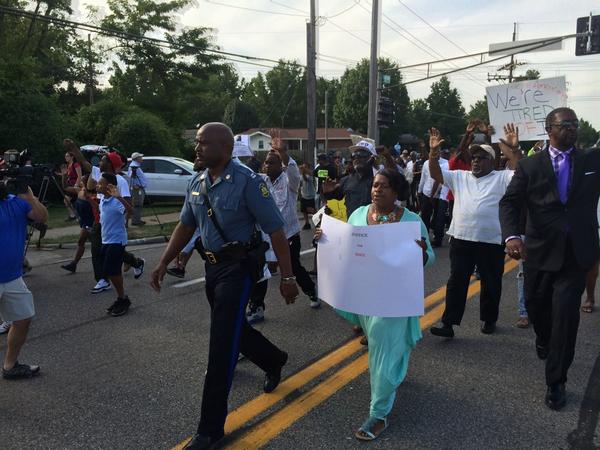- Joined
- Feb 9, 2004
- Messages
- 17,078

5 Things We Can Learn From Ferguson's New Leadership
How respect, compassion and servanthood eased the tensions in a dire situation.
The lede from the CBS News article covering Thursday night’s protest admirably sums up the change in atmosphere:
County police in riot gear and armored tanks gave way to state troopers walking side-by-side with thousands of protesters as the St. Louis suburb where an unarmed black teen was shot by a city police officer overwhelmingly avoided violence Thursday after nearly a week of unrest and mounting public tension.
A night before, the scene was radically different. Local police outfitted in military gear fired rubber bullets and tear gas into crowds. Individuals among the protestors threw Moltav cocktails. Tanks rolled through the street, as members of the media were arrested and assaulted for doing nothing more than trying to capture the crackdown on video, and document the show of force by police.
The week-long protests started after a vigil for Michael Brown, an unarmed black teen who was shot and killed by an officer over the weekend. Police say Brown assaulted the officer, but witnesses told reporters Brown had his hands up attempting to surrender when he was shot multiple times. Police have been slow to release details about the shooting, and when isolated incidents of looting broke out following the public vigil, a crackdown began. The mostly peaceful protestors, many of whom walked the streets with signs that read "Hands up, don’t shoot," encountered police decked out in military gear, rolling through the streets in tanks.
So, what changed in the course of a single evening? Here’s what we can learn from the new response last night.
They Recognized Injustice and Did Something About It.
It shouldn’t have taken such a tragic incident to bring such obvious racial disparity to light, but the media and officials are taking notice of what’s happening in Ferguson. As this story in The Washington Post notes: “About two-thirds of the city’s 21,100 residents are black … The police force has 53 members, and three of them are black. The city’s mayor and police chief are white, as are most of the members of the Ferguson City Council.”
From CNN: “A Missouri Attorney General report on racial profiling last year showed that there were 611 searches in Ferguson: 562 of blacks; 47 of whites; one of a Hispanic; and one of a Native American.”
As media reports indicated that local police were using obsessive measures during the protest—including arresting reporters—Gov. Jay Nixon finally took action. Nixon asked “a highway patrol captain with ties to the local community to lead the effort.” Capt. Ron Johnson (pictured in the tweet below), told reporters, “I've assigned all police assigned to this detail to take their gas masks off.” Instead of cracking down on protestors, he marched with them.
Obviously, fixing the broken system in Ferguson will take a long time, but hopefully last night can serve as the first step in the right direction.
They Took the Complaints Seriously.
Again, it’s taken far too long for the rest of the country to witness the racial inequality among local officials and the citizens of Ferguson, but the government has taken notice.
Thanks to the powerful message of protestors who’ve boldly taken to the streets with “Hands up, don’t shoot” posters, the message spread on social media and the military-like response was documented by the press and online. Even the
President addressed the situation.

They Weren’t Afraid of Drastic Measures.
Once state officials recognized how badly local police were responding to the mostly peaceful demonstrations, they took a dramatic step: They replaced the leadership.
From ABC News on Wednesday: “The governor said the streets of Ferguson, a suburb of St. Louis, have ‘looked like a war zone, and that's not acceptable. ... Literally, the eyes of the nation are upon us.’”
As the image below (from the LA Times) shows, the governor even met local community leaders, attended prayer rallies and visit the area to talk about local law enforcement’s tactics and determine a better solution.

They Picked the Right Leadership.
Capt. Ronald S. Johnson commands nearly 300 state troopers, and is a well-respected veteran law enforcement officer who’s served for nearly three decades. Not only that, but he understands the community, because he’s from Ferguson. He told reporters:
They Showed Compassion Instead of Force.We are going to have a different approach and have the approach that we’re in this together. I understand the anger and fear that the citizens of Ferguson are feeling, and our officers will respect both of those … I’m not afraid to be in this crowd. I grew up here, and this is currently my community and home
Before taking over, Capt. Johnson said, “When I see a young lady cry because of fear of this uniform, that’s a problem.” He told his officers not to wear gas masks and actually marched with demonstrators.
Johnson understood the frustrations of the people of Ferguson, and saw that responding with compassion and openness was more effective than a show of force and strength.


What's Next
There's a lot we still don't know, including the exact events that led to Mike Brown's death. Also, it will certainly take more than one good day to repair the damage that has been done in Ferguson. However, the commitment Ferguson's citizens have made to peaceful protest has resulted in a dramatic shift, and Ferguson's new atmosphere is conducive to forgiveness and reconciliation. It's as good a place to start as any.
article source: http://www.relevantmagazine.com/current/5-things-we-can-learn-fergusons-new-leadership